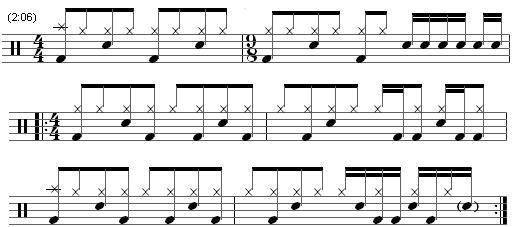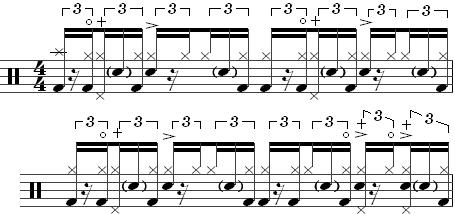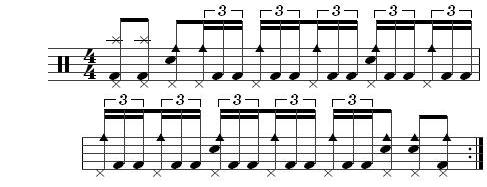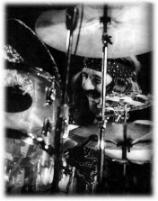Spotlight: Led Zeppelin's John Bonham
Born on May 31, 1948, in Redditch, Worcestershire, England, John Henry "Bonzo" Bonham went on to become one of the most influential rock drummers of all time. In 1968, Bonham joined guitarist Jimmy Page, vocalist Robert Plant, and bassist/keyboardist John Paul Jones to form the legendary rock band that became known as "Led Zeppelin". During his career with Led Zeppelin that spanned from 1968 until his tragic, untimely death in 1980, John Bonham almost single-handedly defined hard rock drumming.
The groundbreaking drumming style of John Bonham was, at once, fiercely powerful and aggressive, yet very dynamic, tasteful, and downright funky. Upon listening to Bonzo's drumming, it becomes apparent that his musical roots are firmly planted in American soul music. Bonham was especially fond of the drummers of James Brown, Stax, and Motown, as well as jazz drumming legends Buddy Rich and Gene Krupa.
To this day, Bonham's influence—direct or otherwise—is clearly evident in the playing of countless rock and metal drummers. John Bonham's drumming has stood the test of time and is never considered "dated"; rather, it sounds just as vital and current today, as it did when it was first recorded. It's important to keep in mind that what Bonham played is often eclipsed by how he played; his feel is an intangible element that should not be underestimated or overlooked.
In this installment of "Spotlight", we'll take a look at some of John Bonham's most notable and influential drum parts. Given his extensive body of work with Led Zeppelin, there are so many to choose from, but I've narrowed it down to a bunch of my favorites. Enjoy!
When The Levee Breaks - In terms of memorable and influential drum grooves, "When The Levee Breaks" is certainly a standout. From the Led Zeppelin IV album (released in 1971), this groove epitomizes John Bonham's swaggering feel and his huge signature sound. When listening to this groove, don't be fooled by the "slap-back" echo, which gives the impression that the notes are doubled.

The beat from "When The Levee Breaks" has been sampled or replicated by many rap and hip-hop artists, the most notable of which are the Beastie Boys on "Rhymin' and Stealin'" from their album "Licensed to Ill".
Kashmir - Another prime example of Bonham's famous sound and feel appears on the epic "Kashmir", from the Led Zeppelin album "Physical Graffiti", released in 1975.
The track begins with the haunting main riff (played by the guitar, bass and strings) which superimposes a "floating" 3/4 feel over a 4/4 drum groove. This basic polyrhythm resolves back to the downbeat of "1" every 3 bars (or 12 beats).

Again, the echo gives the impression that bass drum notes are doubled, but they are not. Viewing the performance of "Kashmir" on the Led Zeppelin DVD confirms this.
The next example - also from Kashmir - begins at the 2:06 mark of the track. The first two bars represent the transition into the bridge section. Notice how the bar of 9/8 throws a slight "curveball" into the mix.
After the 9/8 measure, the bridge kicks in with a powerful
unison riff. Bonham supports the riff with his bass drum, and then finishes
off the phrases with tasteful examples of call and response.

Fool In The Rain - Appearing on the "In Through the Out Door" album (recorded in 1978 and released in 1979), "Fool In The Rain" contains one the most renowned and recognizable drum grooves of all time—the half shuffle. The ghost notes (indicated with parenthesis) really add some flavor and motion to the groove. This is one of my favorite grooves to play.

Note * This groove can be notated in various ways; this is just the one I prefer.
Good Times, Bad Times - This track from Led Zeppelin's self titled 1969 debut album (often referred to as "Led Zeppelin I") showcases—among other things—John Bonham's great bass drum technique. In this example, I've transcribed one of Bonham's signature licks: fast triplets (16th note triplets, in this case) played between the right hand and right foot. This excerpt appears at :24 and :28 of the track.

Later in "Good Times, Bad Times" (2:13 into the track), Bonham extends his famous triplet lick for nearly two bars. It takes a great deal of control to play this smoothly.

The Crunge - Led Zeppelin were never afraid to venture into the realm of odd time. "The Crunge" (from "Houses of the Holy", released in 1973), starts off with a groove in 9/8 time that is about as funky as 9/8 can be! It may help to think of 9/8 as 4/4 with an extra 8th note (1/2 beat).

The Ocean - Included on Led Zeppelin's 1973 release, "Houses of the Holy", "The Ocean" contains yet another landmark Led Zep riff. This riff is a two bar phrase consisting of a bar of 4/4, followed by a bar of 7/8. I've included two transcriptions of this groove; the first is a stripped down version and the second is a more detailed version, which includes ghost strokes on the snare.


Wrap Up
John Bonham has left an indelible mark on rock drumming, and his influence will be felt for many years to come. The excerpts included here only scratch the surface of Bonzo's impressive body of work with Led Zeppelin. Check back here from time to time, as I will be adding more John Bonham excerpts to this article. Remember, I do requests, so feel free to make suggestions. I hope you enjoyed this installation of Spotlight, and thanks for reading!
